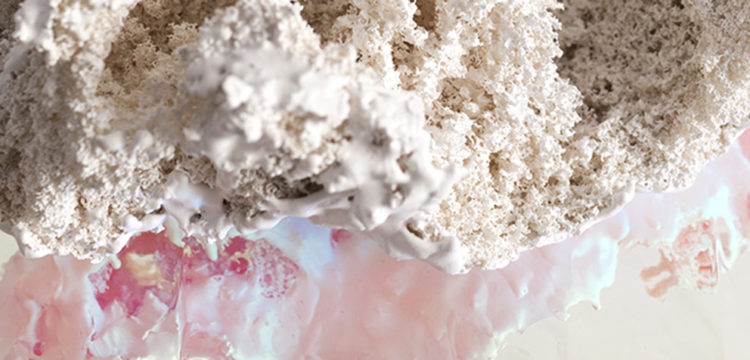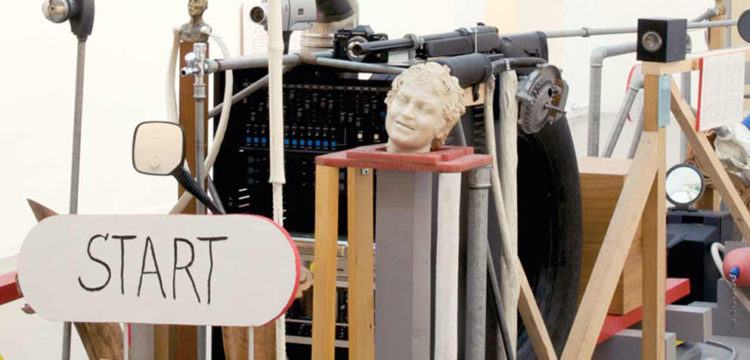Between Archeology and Space Exploration
Human agency and ideologies related to progress, buckling in the face of overwhelming natural forces in the work of Juliana Cerqueira Leite
Juliana Cerqueira Leite’s exhibition Convergence at Alma Zevi in Venice, brings us face to face with sculptures originally made for her first museum exhibition in Europe held at the National Archaeological Museum in Naples (July–September 2019). The exhibition review is entwined with fragments of email correspondence with the artist between August and September 2019.
Walking into the exhibition at Alma Zevi’s gallery in Venice, one is immediately struck by the disparity in scale between the works on display and the size of the space. Zevi’s small gallery space is a small shop in a Venetian Salizzada (one of the first paved streets). On view are three sculptures by Cerqueira Leite composed of assemblages of casts of her own body. Each work is placed on a high plinth, so high as to protect them should acqua alta return. The damages left by the November floods—overall the worst in over 50 years—left slight damp marks on the walls, and salt on the floors. A further reminder of nature’s preponderance on humans. Within the gallery, the sculptures appear grand, but the limited space forces one into an intimate relationship with them. Their distant monumentality is transformed by the close encounter with their materiality. The materials used range from plaster body casts, to sand collected in Pompeii, seashells, glass tanks and metal parts connected to the cast of knees or elbows. Juliana’s work helps us see, in her own words, “human agency, and ideologies related to progress, buckling in the face of overwhelming natural forces.” Her practice engages with space exploration, with the so-called Anthropocene, with archaeology and, finally, with ideas around subjectivity.
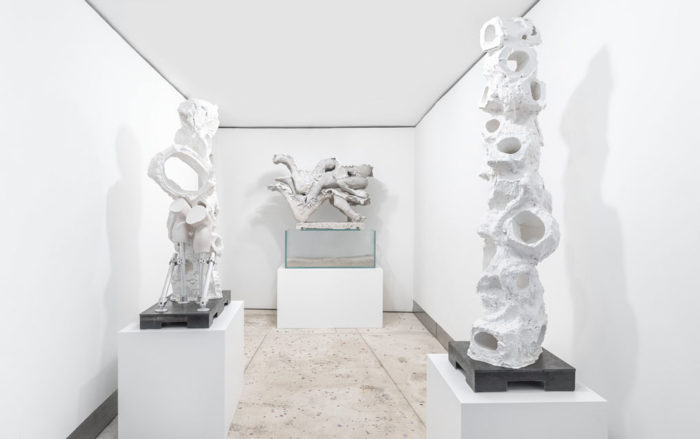
Juliana Cerqueira Leite, Convergence, ALMA ZEVI Venice, installation view. Photo Enrico Fiorese.
The sculptures on display are the product of extensive research in the archives of both NASA and choreographer Martha Graham as well as Pompeii, which are held at the Museo Archeologico Nazionale di Napoli (MANN). In fact, it is at MANN that her sculptures were first exhibited this past summer. The title of the current gallery show Convergence, and the exhibition project at MANN Orogenesis, both reference geological terms that indicate the movement of tectonic plates. In regards to how the exhibition title relates to her sculptural practice, Juliana explained: “I’m interested in how it’s geological but has strange overlaps with words that are more commonly associated with biological and psychological things: organs, orgone energy, origin. I started to see how a lot of the repeated human pose that I’m addressing in this show has to do with how human anatomy behaves under certain kinds of pressures or releases. This dynamic of compression and dehydration or release that returns the body to this specific position became for me a way to talk about the tectonic activity of the region in which the exhibition is located, as well as the larger notions of human agency, and ideologies related to progress, buckling in the face of overwhelming natural forces.”
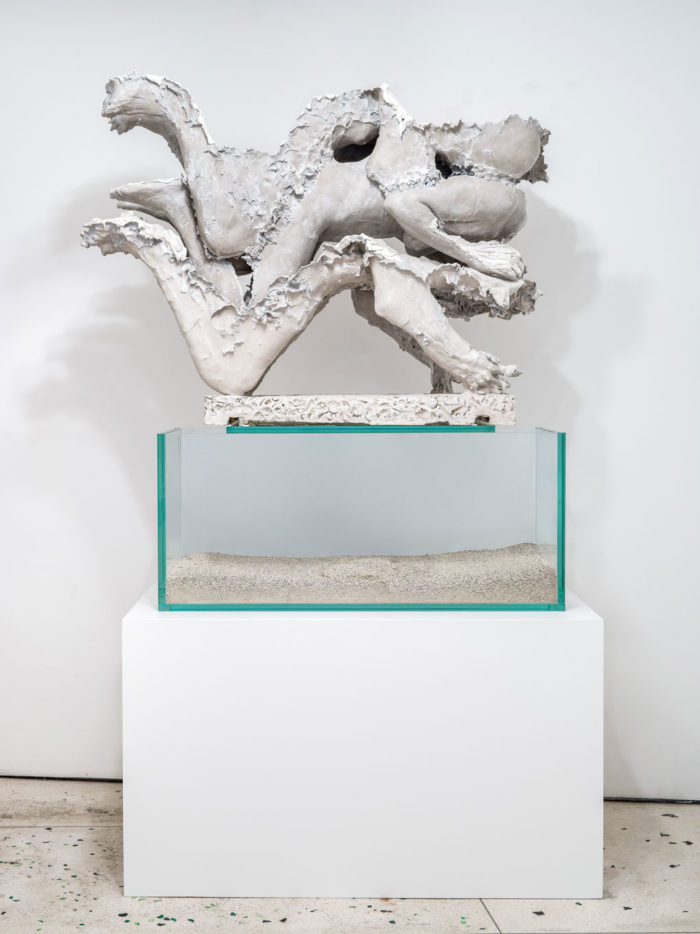
Juliana Cerqueira Leite, Calcify, 2019. Photo Enrico Fiorese.
The inspiration for Orogenesis was linked to Pompeii’s tragic history. The point of departure were the calchi created by archaeologist Giuseppe Fiorelli through his homonymous casting process that filled the voids left by the bodies buried under Mount Vesuvius’s ash and lava in 79 A.D. Fiorelli’s archaeological method informed Cerqueira Leite’s interest in the natural posture taken by human bodies under conditions of duress. Juliana’s research revealed that the same position was commonly found in images of Martha Graham’s choreographies, through which she studied how the human body asserted subjective agency. The same position of buckling, called pugilistic attitude when found in corpses, is also taken by the body in the absence of gravity. Astronauts are trained to manage this position, renamed Neutral Body Posture, before space expeditions.
The sculptures on show (both at Alma Zevi and at MANN) materialize Cerqueira Leite’s efforts to trace how the body changes in relation to its environment, and vice versa. For almost a decade, Cerqueira Leite has employed casting to formalize her concerns. Using a range of materials from clay to silicone, fiberglass and polymorph plastic, the artist has investigated how the human body can affect matter, and, in turn, how the material constricts and records the traces left by her own body. Casting is a technique deeply rooted in Neo-Classicism and in the so-called discovery of Antiquity. Since then, it has been an instrument to preserve and circulate the remains and artifacts left by the Roman Empire and Ancient Greece, which became the very origin of Western culture. As the New Art History teaches us, casting has been more recently used to debunk some of the myths about Modern Art’s originality and uniqueness. Taking distance from the idea that each artwork and movement must be unique leads to the opening of artistic canons.
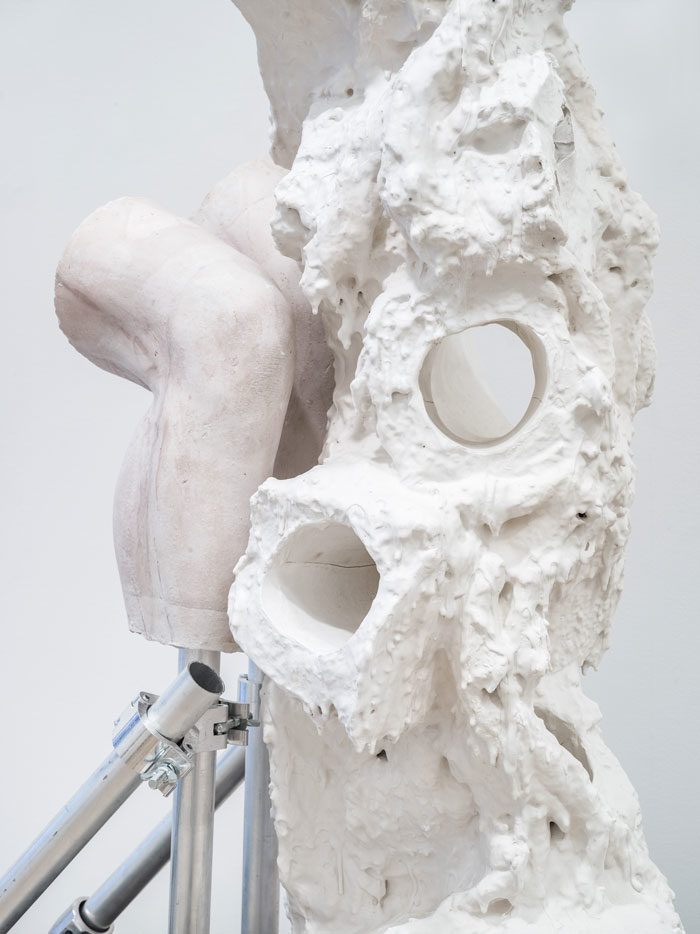
Juliana Cerqueira Leite, Contraction 3 (detail), 2019. Photo Enrico Fiorese.
Once the notion of value is disentangled from that of originality, art history may recognize a multitude of genealogies and origins that may replace a singular linear one. When asked about how she understood the relationship between antiquity, modernity and contemporaneity, Juliana explained: “If the move away from modernity has been one of a deconstruction of metaphysics, dichotomies, universals and an admission of plurality in being, an attempt at more inclusive dialogues then what can be next? When I think about new sorts of thinking in relation to contemporaneity I think of the real potential for a re-definition of the subject, away from the sort of market-led and labelled variation on individualism and independent workaholic gig economy that defines us still through fixed forms, patterns of consumption and productivity to one that is much more led by true changeability, transformation and a real biodiversity of being.”
The artist’s employment of casting implies a confrontation of the narratives of modernity, and it brings forth her modes of engagement with archaeology. Calcify (2019), is a stack of three frontal body casts, positioned over another cast of an earth block dotted with fossil-like seashells, mounted over a glass tank filled with a layer of sand from Pompeii. The front half of the cast bodies is clearly visible. Meanwhile, their concave backs are made of un-manipulated lumps of poured plaster that spill over their smooth front. The pose of the three casts is the same as that found in the calchi: bodies bent due to the scorching heat of the volcanic eruption that buried them. References to archaeology reveal how Juliana’s sculptural practice materializes the passing of time as seen in fossils, or earth stratifications, or even in her own body’s movement. I asked Juliana about a tension between archaeology and the corporeal: “Moving through these spaces, excavating room for my body, is in a way an attempt to shift the definition of the subject. There’s something similar to archaeology in that, some of the artworks I make are literally dug out from under mud and I have never seen them until they come out of this lump of clay. There’s a reveal. I also occupy these spaces, kind of like an artifact myself, or fossil […] I like this idea of the persistence of objects facilitating the persistence of the past and the ideas these objects seem to support. In some ways the human body performs the same function: it is an archive of our DNA and evolution that performs itself persistently through reproduction. What if we think of the human body as an artifact?”
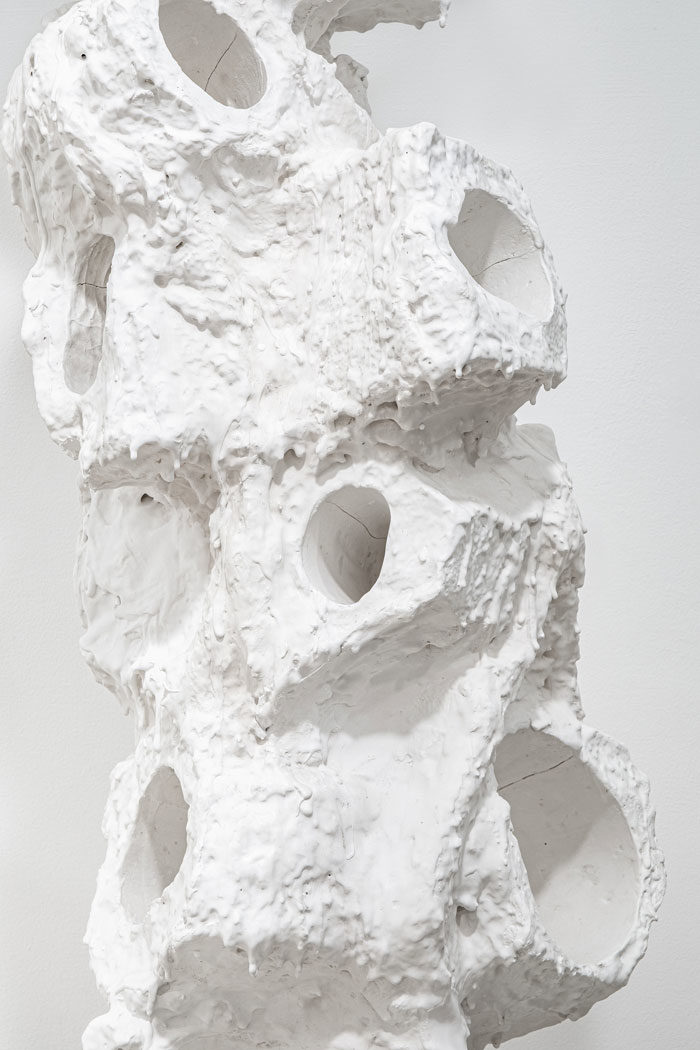
Juliana Cerqueira Leite, Contraction 2 (detail), 2019. Photo Enrico Fiorese.
While her study of the body alongside fossils and artifacts as persistent objects is rooted in archaeology, it is further understood in relation to our present time, frequently denominated the Anthropocene era: our current geological age defined by the impact (agency) humans have on the planet. The backside of the impact humans have on nature, is how nature affects humans and in particular their bodies. The issue of human agency is at the centre of Juliana’s artistic experimentation. By bending, contorting, casting and fragmenting her body, Juliana plays on the tension between the material dictating her body’s form, and her body shaping the material. The Anthropocene implies that the responsibility for climate change is on humans, making them (and no other species) protagonists. Humans had lost this role when Copernicus discovered that the earth was not at the centre of the universe. Donna Haraway speaks of the Copernican revolution as a wound inflicted on the narcissism of the ontological human, but thanks to the Anthropocene, humans are back on the podium. In turn, Bruno Latour thinks of the Anthropocene as a Counter-Copernican revolution (because humans are once again at the centre of discourse) and equates the ecological crisis to a political crisis. He explains that if we want to have a political philosophy adjusted to the climate transformation it is the definition of a subject, of what it is to have agency, that needs to be modified. In light of these important contributions, Juliana’s question about what is it to have agency on this planet bares monumental consequences.
The sculpture Contraction 3 (2019), other versions of which exist dating back to 2013 under the more explicit name Pompeii, is a totem-like assemblage of plaster casts with metal supports. The resulting structure is a perforated tower, almost of Cerqueira Leite’s height. The main structure is composed of stacked plaster moulds of the artist’s body parts that bend (wrist, elbows, ankles etc..). Two perfect casts of the artist’s bent knees are attached to it. Two types of cast assembled in the same sculpture, heighten the tension between the interior and the exterior of the casts. The poured plaster on the exterior of the moulds appears in sharp textural contrast to the smooth skin marks left in their internal surface. Further still, part of the sculpture is held in place by metal tubes that look like prosthetic or cyborg limbs. The intrusion of this artificial element in the very organic and fluid composition hints at the potentialities of change and adaptation for the body.
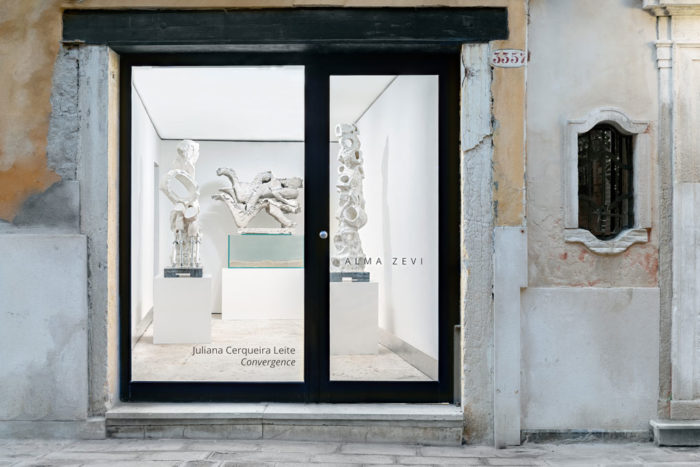
Juliana Cerqueira Leite, Convergence, ALMA ZEVI Venice, installation view. Photo Enrico Fiorese.
Experimenting with how the body may transform in tandem with the environment is driven by a reflection around subjectivity and how ancient and contemporary artifacts inform our sense of self and belonging. Next to the portraits of Pompeiian noblewomen and sculptures of deities on display at MANN, Cerqueira Leite’s sculptures—carved from within—appear in stark contrast. Looking at her body casts displayed alongside the sculptures in the collection, I started interrogating myself about how much the subjectivities reflected in these objects had changed. How have the dynamics according to which women enter museums, even archaeological museums, changed? Juliana elucidated this point: “I think of the nude bodies of women in Museums as somehow castrated and de-placed. They don’t have a reality to them that allows them to become political. It’s like they are only ever symbolic in their capacity, or iconographic, belonging to a world of poetry and mysticism and never to the real world of the body politic. If real women enter the museum this creates a true disruption of the historical narrative. […] I think women have a different relationship to space because we’ve been historically not allowed to occupy it. Our spaces are the unseen, even symbolically if you think of the vagina as something that is internal, the clitoris as an organ that is largely hidden. I don’t think it’s super useful to try to essentialize femininity through anatomy, but I think women have been more curious about the unseen perhaps because we are so often made invisible.”
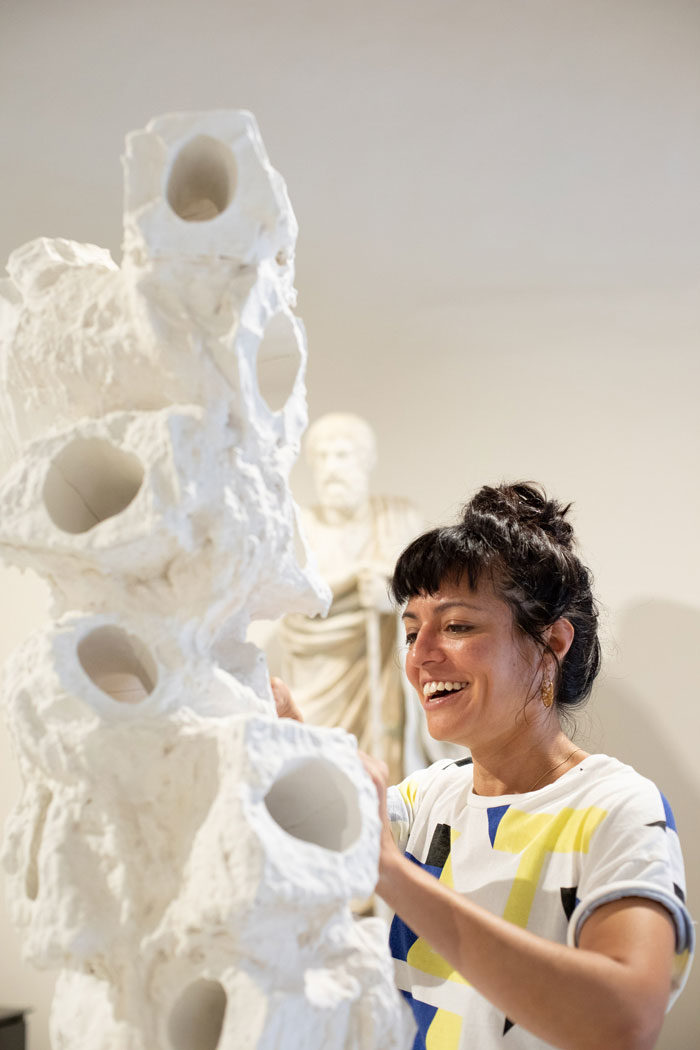
Juliana Cerqueira Leite working on Contraction 3 for the Orogenesis show at MANN, Naples, 2019. Photo Enrico Fiorese.
The way Juliana presents the naked body in her sculptures de-centers our perspective on what is made visible and why. The subjectivity she expresses in her work reflects a willingness to alter the narrative currently presented to us. The hope is that we can move away from those ideologies related to progress and production—embedded in our history and in the artifacts that comprise it—that we are seeing in the process of collapse. Juliana’s rendition of her own body is always partial, fragmented and recomposed. What she may be pointing towards is simultaneously the cause of our fragmentation and the possibility of our bodies to reconfigure themselves. I would like to conclude reiterating some of the open “what if” questions brought up by Juliana: “If the move away from modernity has been one of a deconstruction of metaphysics, dichotomies, universals and an admission of plurality in being, an attempt at more inclusive dialogues then what can be next? […] “What if we think of the human body as an artefact? […]Our body plans have evolved on this planet, and what will happen if or as we inhabit others? Why assume that, as our bodies change in these new environments, which they inevitably will, we will retain any fealty to our humanity?”
These questions shift the discourse from a sterile “what are we going to do?” or “what is the world going to look like?” to a productive “what if.” Feminist scholar Rosi Braidotti lists the “as-if” approach (taking a cue from performance artist Laurie Anderson) as one of the tools available that can help us shift perspective, foster reversibility and the opening up of new possibilities. Though there are no clear answers, I feel my ability to imagine, invent or create reawaken from its dormant anthropocentric stupor.


